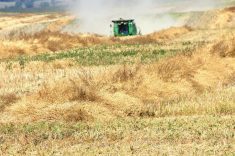What do Saskatchewan sheep producer Colleen Sawyer and Mongolian warload Genghis Khan have in common?
Not much.
But after a recent trip to Khan’s old stomping grounds, Sawyer has a better understanding of the region, its geography and people and the challenges facing its agricultural sector.
“It was a real eye opener,” said Sawyer, a sheep farmer from Pike Lake, Sask., about 30 kilometres south of Saskatoon.
“We were trying to get sheep farmers in Inner Mongolia to manage their farms in a more professional and more technical way, but so much of what they do there is based on culture and tradition, it’s very hard to get them to change their ways.”
Read Also

Alberta researcher helps unlock the economics of farming
Lethbridge Polytechnic researcher helping agriculture producers with decision-making tools in economic feasibility
Sawyer, who works with the Saskatchewan Sheep Commission, was asked to travel to Inner Mongolia last year by the managers of a sustainable development project sponsored by the Canadian International Development Agency.
The purpose of the five-year CIDA project is to increase herder profits, stop erosion on the Asian steppes and establish better management practices on the vast grassland areas that cover Inner Mongolia, a remote Chinese province that borders the country of Mongolia.
Traditionally, herders in Inner Mongolia have increased income by increasing livestock numbers.
This practice was sustainable in the past because pasture availability was virtually unlimited, said Bazil Fritz, a former Saskatchewan Agriculture employee who now serves as technical specialist with the CIDA project.
However, since 1950, livestock numbers in Inner Mongolia have tripled and the grasslands have suffered.
“There’s a terrific erosion problem there and it’s really come to light in the last few years,” Fritz said during a recent visit to Canada.
“That’s the main thing we’re trying to do is to stop the (erosion) and improve farmers’ incomes at the same time.”
Because most farmers in Inner Mongolia produce sheep, Fritz asked Sawyer to travel to China to meet with producers.
A few months later, Sawyer was en route to Hulunbeier, the main city in Hailaer district in Inner Mongolia. Her assessment of the region was bleak.
The Inner Mongolian people are hospitable and the geography was incredible, she said, but farming practices were backward and living conditions were unlike anything she had seen before.
When Sawyer arrived in Hulunbeier, the taps in her hotel emitted dirty, black water with a stench that precluded its use for bathing or drinking.
“And that was a good place compared to some others where we could have stayed,” Sawyer said, chuckling.
Trips to rural areas outside of Hulunbeier were equally memorable.
There was no apparent infrastructure other than a few poorly maintained trails that linked one remote village to the next.
“Sometimes we’d drive two hours in the worst conditions you could imagine, but it was still better than staying in the villages themselves.”
Sawyer described Inner Mongolia as an endless sea of grass.
“There are grasslands as far as the eye can see, for miles and miles and miles and miles,” she said. “It’s absolutely amazing.”
Residents live in tiny circular huts, known as yurts, and derive the majority of their income from livestock sales.
Their diet consists largely of mutton, which is usually boiled over a fireplace in the middle of the yurt.
In the absence of trees or gas lines, the only available and affordable fuel source is manure, which is collected, dried and stockpiled beside the yurt for cooking and heating.
Inside, furniture is sparse and there are no beds. A few families own televisions. In some yurts, families sleep on a round concrete slab that can be heated from beneath using embers.
The smell and air quality inside the yurts are terrible, Sawyer said. Sanitary facilities are rudimentary.
Outside the yurt, the most prevalent measure of wealth is livestock.
Almost every household owns a flock of sheep and many also own a herd of horses, although the value of horses was unclear, at least by western standards.
Some horses are used as a means of transportation but most serve only to enhance the status of their owner.
There are few if any fences, meaning horses can graze freely, causing significant damage to sensitive grasslands and contributing to the erosion problem.
“It’s nothing to see herds of 200 or 300 wild horses roaming around and there’s no concept of grazing management, whatsoever,” Sawyer said.
“But so much of what they do is rooted in culture and tradition. Horses have been a symbol of wealth and status for centuries.”
By western standards, Inner Mongolia’s sheep industry is poorly regulated and badly managed, she said.
Production problems are common and an established, equitable marketing system is nonexistent.
According to Sawyer, the prevalent breed of sheep is the Hulunbeier, a hair breed that does not require shearing. It is well-adapted to the dry, barren conditions of Inner Mongolia.
Sawyer described the breed as poorly muscled and extremely docile with a huge, fatty tail.
It is likely the fat reserves stored in the tail help sustain the animal through the winter or in times where nutrients are scarce. Hulunbeier sheep can also survive long periods without water, an important trait given the lack of moisture in the region.
Herders in Inner Mongolia live a semi-nomadic lifestyle, moving their yurts and livestock between summer and winter grazing areas.
In the dry season, water is scarce and must be tightly rationed. Livestock are always thirsty but are able to survive for several days at a time without water, Sawyer said.
Sheep are slaughtered throughout the year and are a dietary staple.
The only form of marketing involves a “middleman” who visits herders occasionally and buys animals for the equivalent of $30 a head.
The animals are not weighed and there is no grading system in place.
Sheep are transported to a regional plant where they are slaughtered and the meat deboned and packaged into rolls for sale in nearby urban markets.
Sawyer said modest incomes have forced herders to be frugal.
The more wealthy residents in a village might own a motorcycle, which is used for transportation and herding. A few own small tractors, but fuel is scarce.
Animals slaughtered for consumption are almost always boiled and every part of the carcass is consumed. Muscle cuts are used in Mongolian hot pots, or soups.
Intestines are stuffed with blood, left to coagulate and eaten later as blood sausage.
The Inner Mongolian diet is supplemented with eggs and an occasional fruit or vegetable, which is imported.
Meals were eaten with a crude, distilled alcohol that smelled similar to diesel fuel, said Sawyer, who sustained herself mostly on imported oranges, which were plentiful during her visit.
“Some of the stuff you’re eating, you don’t even know what it is,” she said, laughing. “But you don’t ask and you don’t dare refuse it because they would be quite insulted. I had to drink the liquor or I wouldn’t have been able to eat the food.”
Sawyer said she and other Canadian visitors were treated as dignitaries by their hosts in Inner Mongolia.
During the visit, Sawyer’s main role was to share her expertise in sheep management and offer advice to local herders, a task made difficult by linguistic and cultural differences.
Even with the help of an interpreter, herders seemed reluctant to accept Sawyer’s advice. Their interest grew when she began offering hands-on seminars about animal handling, nutrition, breeding and lambing.
“I think they were a bit apprehensive at first but it was just a matter of gaining their respect and trust,” she said.
“I raise sheep myself so I think they recognized that. I kept things simple and used a lot of humour and eventually they started to warm up to me.”
Fritz and Sawyer agreed that reducing erosion and establishing more sustainable grazing systems will require wholesale changes.
For example, reducing flock numbers without affecting income levels will require more intensive herd management techniques, better nutrition, improved marketing mechanisms and the expansion of the region’s rudimentary watering systems.
Other improvements could also be made.
- Better sheep genetics could lead to bigger carcasses.
- Fences could reduce pressure on overtaxed grasslands.
- Tagging and record keeping could monitor bloodlines, lambing rates and mortalities.
- Selective culling could be introduced.
To that end, Fritz’s next goal is to establish a handful of demonstration farms in Inner Mongolia that will adopt modern management techniques and illustrate how the size of a flock is not the only factor determining its worth.
“Essentially, we’re trying to introduce a more businesslike approach,” Fritz said. “We’d like to demonstrate how you can reduce your animals and still make as much money….”
Fritz said small breakthroughs in communication are critical in the effort to bring change to Inner Mongolia.
“When you get there, it seems so obvious what has to be done to improve the situation, but it’s not that easy,” Fritz said.
“Change happens very slowly and it takes place little by little. It’s a very slow process and you have to take it one step at a time.”















